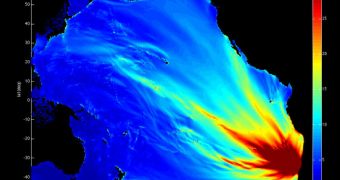On February 27, a very powerful earthquake struck Chile, killing at least 700 people, and causing important damages to a host of cities. The tectonic event triggered a modest-sized tsunami, which spread throughout the Pacific Ocean. Tsunami warnings were given in 53 countries, but damages were not very significant where it struck. The tremor was recorded as having a magnitude of 8.8 degrees, and lasting for an average of three minutes. It was felt in all neighboring countries, including Argentina and Peru. But geologists say no one should have been surprised that the earthquake happened, ScienceNow reports.
They explain that the stage was set for another devastating tectonic event to take place in this region, which is one of the most active and dangerous in the world. Chile is located along a very unstable fault line system, where the Nazca Plate of the Pacific Ocean flows under the South American plate. This causes extreme friction, which at times leads to vast accumulations of energy under the crust. When these energies are released, massive tremors are triggered. The largest earthquake ever recorded, of magnitude 9.5, also took place in Chile in 1960. Experts now say that even the famed naturalist Charles Darwin may have predicted the new tremor, several centuries ago.
During his voyages on the equally-renowned ship the Beagle, Darwin visited Chile, and observed just how much tremors had deformed its landscape. The scientist visited the country shortly after the 1835 earthquake, which had a magnitude of 8.5 degrees. His studies there allowed geologists to conclude later on that – if a fault ruptures once – then it will most likely do so again when enough strain accumulates. The resulting tremor is very likely to have a similar magnitude to the original one. Experts now believe that the particular fault line segment that ruptured a few days ago was building pressure since 1835.
They argue that all the other major earthquakes that struck the region over the past century or so affected portions of the fault lines that did not overlap with the one that caused the 1835 tremor. Under these conditions, they argue, something was bound to give way sooner or later. These predictive studies are very difficult to conduct, mostly because geologists can't attach fixed dates to when a new tremor will strike. They explain that pressure can take either decades, or centuries to build, and that there is currently no way of gaging the amount of energy that gets locked in a fault line system.

 14 DAY TRIAL //
14 DAY TRIAL //